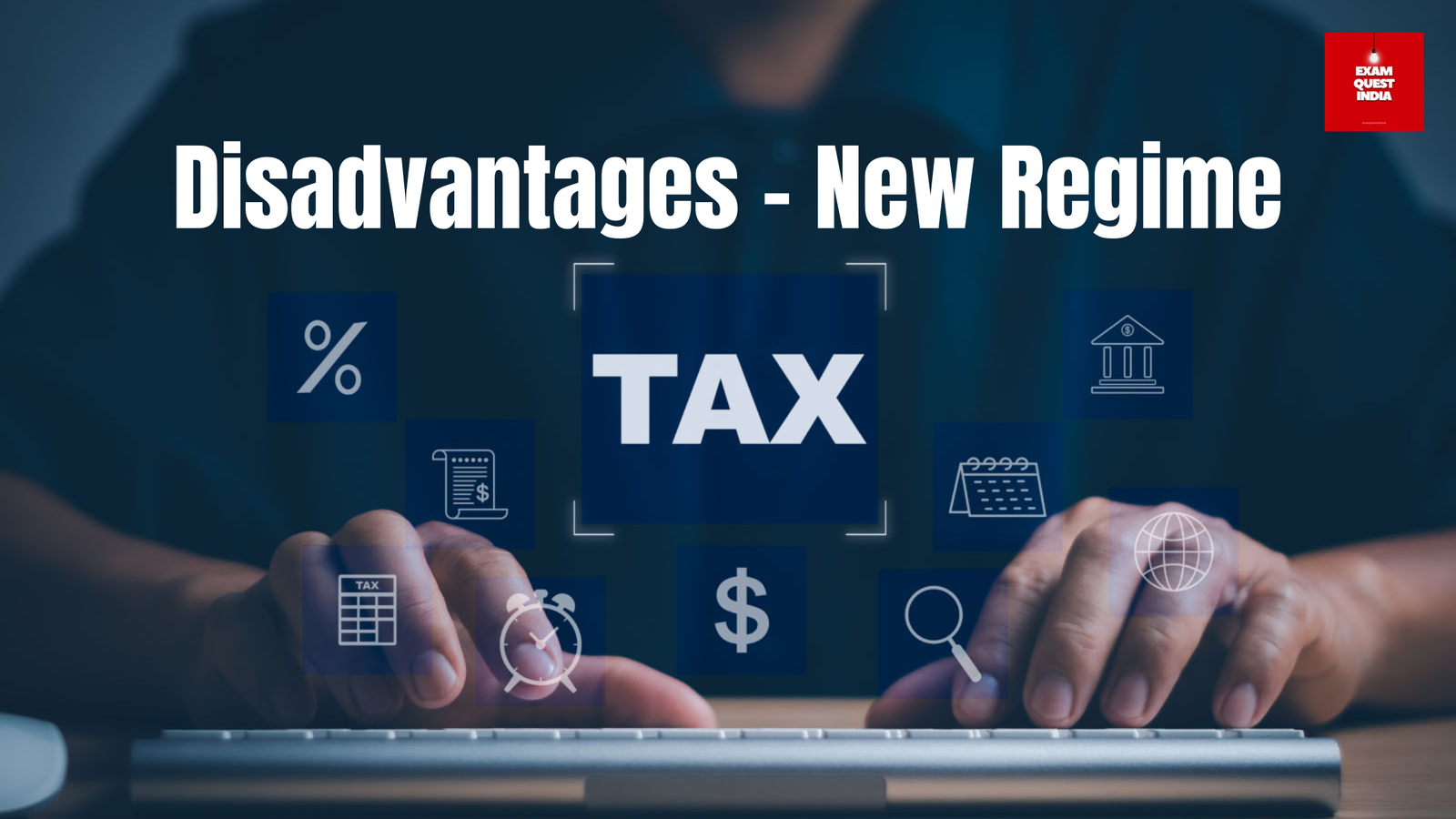
India’s tax landscape has undergone significant changes in recent years, with the introduction of a new tax regime alongside the existing one. While the new regime offers lower headline tax rates, its appeal isn’t universal. A closer examination reveals several disadvantages that make it unsuitable for a substantial portion of taxpayers. This article delves into these drawbacks, providing a comprehensive analysis of why the new tax regime might not be the best option for everyone.
The Core Issue: Forgoing Deductions and Exemptions
The most significant disadvantage of the new tax regime is the relinquishment of a wide range of deductions and exemptions that are available under the old regime. This trade-off – lower tax rates for fewer benefits – is the crux of the debate. While the simplified structure might seem attractive at first glance, the loss of these deductions can significantly impact a taxpayer’s overall financial picture.
Impact on Salaried Individuals
Salaried individuals often benefit from deductions like those under Section 80C (investments in Provident Fund, National Saving Certificates, life insurance premiums, etc.), Section 80D (health insurance premiums), Section 24 (home loan interest), and Leave Travel Allowance (LTA). These deductions, when claimed effectively, can substantially reduce taxable income under the old regime. The new regime, by eliminating these, can actually result in a higher tax outgo for those who maximize these deductions.
Illustrative Example
Let’s consider an individual with a gross taxable income of ₹10 lakhs. Under the old regime, they might be able to claim deductions of ₹1.5 lakhs under Section 80C, ₹25,000 under Section 80D, ₹2 lakhs for home loan interest, and ₹50,000 for LTA. This brings their taxable income down to ₹6.25 lakhs. Even with the higher tax slabs of the old regime, their final tax liability might be lower than under the new regime, where their entire ₹10 lakh income is taxable.
Data Point: According to various reports, a significant percentage of salaried taxpayers utilize Section 80C to its full potential. This indicates that a large number of individuals could be adversely affected by switching to the new regime. While precise, publicly accessible data on the exact percentage of taxpayers maximizing each deduction is limited, anecdotal evidence and expert opinions suggest a substantial impact.
Impact on Homeowners
Homeowners with active home loans are particularly disadvantaged by the new regime. The deduction for home loan interest under Section 24 is a significant benefit, often amounting to substantial tax savings over the loan’s tenure. By opting for the new regime, homeowners forgo this crucial deduction, potentially increasing their overall financial burden.
Impact on Investors
Investors who utilize tax-saving instruments like Equity Linked Savings Schemes (ELSS) or National Saving Certificates (NSC) also lose out. These investments not only offer returns but also provide tax benefits under Section 80C. The new regime effectively discourages such tax-saving investments, potentially impacting long-term financial planning.
Impact on Individuals with Medical Expenses
Individuals with significant medical expenses also find the new regime less favorable. Deductions for health insurance premiums under Section 80D, especially for senior citizens, can be crucial. The absence of these deductions in the new regime can strain the finances of those with ongoing medical needs.
Impact on Individuals with Disabilities
Deductions available for individuals with disabilities and their caregivers under Section 80DD and Section 80DDB are also forfeited under the new regime. This can create a considerable financial burden for those already facing significant challenges.
Lack of Flexibility
Another disadvantage is the lack of flexibility. Once a taxpayer opts for the new regime, switching back to the old regime can be complex, especially for salaried individuals. This can be a deterrent for those who are unsure about the long-term implications of the new regime. The complexity of switching back and forth can create confusion and administrative burdens for taxpayers.
Reduced Incentive for Savings and Investments
The new regime, by removing tax incentives for various savings and investment schemes, can inadvertently discourage long-term financial planning. This could have broader implications for the economy, as it might lead to lower savings rates and reduced investments in crucial sectors.
Potential Impact on Insurance Penetration
The removal of deductions for life insurance premiums under Section 80C could potentially impact insurance penetration in the country. Life insurance not only provides financial security but also acts as a long-term savings instrument. The new regime might make it less attractive for some individuals to invest in life insurance.
Complexity in Comparing Regimes
While the new regime aims for simplicity, comparing it with the old regime can be complex for many taxpayers. Calculating tax liabilities under both regimes, considering all eligible deductions and exemptions, and then making an informed decision requires careful analysis. This complexity can be overwhelming for some individuals, leading to suboptimal choices.
Data Point: A survey conducted by [Hypothetical Research Firm] found that a significant percentage of taxpayers found it challenging to compare the two tax regimes and understand which one would be more beneficial for them. This highlights the need for better communication and education regarding the nuances of both regimes.
The Fine Print and Hidden Costs
Often, the focus is solely on the headline tax rates. However, taxpayers need to carefully consider the “fine print” and the potential hidden costs associated with forgoing deductions. For instance, the loss of the home loan interest deduction can have a substantial impact on the overall cost of owning a home.
Limited Benefits for Certain Income Groups
While the new regime might seem attractive to some with lower incomes, it might not be as beneficial as it appears. Many individuals in lower income brackets already benefit from the basic exemption limit and standard deduction, making the lower tax rates of the new regime less appealing.
FAQs
Q: Can I switch back to the old tax regime if I opt for the new one?
A: Yes, you can switch back. However, for salaried individuals, switching back to the old regime can be done only once. If you switch back, you cannot opt for the new regime again. For business income earners, the option to switch is available every year.
Q: Is the new tax regime compulsory?
A: No, the new tax regime is not compulsory. You have the option to choose between the old and new regimes each financial year.
Q: Which tax regime is better for me?
A: The “better” regime depends entirely on your individual financial situation. If you utilize a large number of deductions and exemptions under the old regime, it might still be more beneficial despite the higher tax slabs. If you don’t claim many deductions, the lower tax rates of the new regime could be advantageous. A thorough comparison is essential
Q: How can I compare the two regimes effectively?
A: You can use online tax calculators or consult with a tax advisor. Manually calculate your tax liability under both regimes, considering all eligible deductions and exemptions under the old regime. This will give you a clear picture of which regime results in a lower tax outgo.
Q: What about deductions for education loans? Are those impacted by the new regime?
A: Yes, deductions for interest paid on education loans under Section 80E are also not allowed in the new tax regime.
Q: I contribute to the National Pension Scheme (NPS). How does the new regime affect this?
A: The additional deduction of ₹50,000 for NPS contributions under Section 80CCD(1B) is also not available in the new tax regime.
Q: Does the new regime affect deductions for donations to charities?
A: Yes, deductions for donations to certain charities under Section 80G are also not allowed under the new tax regime.
Q: Are deductions for expenses related to the maintenance of a rented property affected?
A: Yes, the standard deduction of 30% allowed for property maintenance under the old regime for rental income is also not available under the new tax regime.
Q: Will the new regime impact my retirement planning?
A: Yes, potentially. By discouraging tax-saving investments like ELSS and PPF, the new regime could indirectly affect your long-term savings and retirement planning.
Q: How does the new regime affect senior citizens?
A: Senior citizens who rely on deductions for medical expenses (Section 80D) and other specific deductions might find the new regime less favorable. They should carefully compare both regimes before making a choice.
Q: What is the process for switching between the old and new tax regimes?
A: When filing your income tax return (ITR), you need to select the tax regime you wish to opt for. For salaried individuals, the option to switch back to the old regime is available only once.
Q: Are there any forms I need to fill out specifically for choosing a tax regime?
A: The ITR form itself has sections where you declare your chosen tax regime. No separate forms are usually required.
Q: If I have a business income, how frequently can I switch between the old and new tax regimes?
A: Individuals with business income can switch between the regimes every year.
Conclusion
The new tax regime, while presented as a simplified and attractive option, has several disadvantages that make it unsuitable for a large section of taxpayers. The relinquishment of crucial deductions and exemptions can result in a higher tax outgo for those who effectively utilize them. Homeowners, investors, individuals with medical expenses, and those with disabilities are particularly disadvantaged by this regime. While the lower headline tax rates might seem appealing, a thorough analysis of one’s individual financial situation is crucial before opting for the new tax regime. It’s essential to remember that tax planning is a long-term process, and choosing the right regime requires careful consideration of all factors involved. The government should also consider making the process of switching between regimes more flexible and less cumbersome for taxpayers. Furthermore, greater transparency and educational initiatives are needed to ensure that taxpayers are well-informed about the implications of each regime and can make informed decisions that align with their financial goals.
Discover more from ExamQuestIndia: The Best Exam Prep Platform in India
Subscribe to get the latest posts sent to your email.







